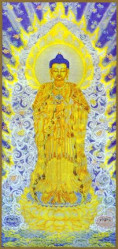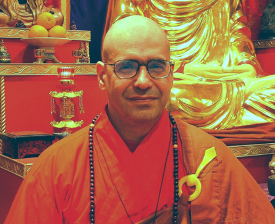History of the Unified Practice
 The unified practice of Pure Land and Ch’an (Zen), known in Chinese as “Ch’an-ching I-chih,” has the ability to open the heart to Compassion through Pure Land practice, and concentrate the mind through Ch’an practice, thus cultivating Wisdom. When Compassion and Wisdom are in perfect balance, our True Self is realized, and Buddhahood is attained.
The unified practice of Pure Land and Ch’an (Zen), known in Chinese as “Ch’an-ching I-chih,” has the ability to open the heart to Compassion through Pure Land practice, and concentrate the mind through Ch’an practice, thus cultivating Wisdom. When Compassion and Wisdom are in perfect balance, our True Self is realized, and Buddhahood is attained.
As early as the 4th century C.E., Master Hui-Yuan (334-416), the First Pure Land Ancestor incorporated meditative discipline into Pure Land practice. In the 7th century, Master Hung-Jen (601-674), the Fifth Ch’an Ancestor encouraged students to recite the Buddha’s name (Nien-Fo), and also advocated the 16 visualization practices laid out in the Visualization Sutra.
A former Korean prince called Wu-Hsiang, incorporated invocational Nien-Fo practice as a key part of Dharma Transmission Ceremonies, thus marking the first time that Nien-Fo practice was explicitly adopted by a Ch’an school. Subsequent schools which taught Nien-Fo practice included the Pao-T’ang School, the Hsuan-Shih Nien-Fo Ch’an School, and the Nan-Shan Nien-Fo Ch’an School.
The first Pure Land Ancestor to advocate unifying Pure Land practice with Ch’an was Master Tz’u-Min (679-748), who found his Pure Land faith while on a pilgrimage to India, hearing stories about Amitabha Buddha and Bodhisattva Avalokiteshvara.
Ch’an Ancestor Master Pai-Chang Huai-Hai (720-814), who wrote the “20 Monastic Principles” which became the blueprint for Ch’an monastic practice, included “Recitation of the Name of Buddha Amitabha.” He stated that, “In religious practice, take Buddha Recitation as a sure method.” Master Pai-Chang also encouraged Amitabha’s name to be chanted during a Ch’an monk’s funeral.
In the 9th century, there were government crackdowns on Buddhist sects, such as the T’ang Hui-Ch’an Persecution (845 C.E.), and the Huei-Ch’ang and Shih-Tsung Persecutions of the late Chou Dynasty (10th century C.E.) which only served to bring Ch’an and Pure Land even closer together. The Ch’an school formally incorporated Nien-Fo practices into its training regimens, and the Pure Land school formally incorporated more meditational elements into its own training system. A key figure in bringing about this synthesis, was a Ch’an monk and Pure Land practitioner called Yung-Ming Yen-Shou (905-975), who taught that the Pure Land is the Realm of the Purified Mind.
In Vietnam, the unified practices were taught by the Thao-Duong School, founded by the Chinese monk Ts’ao-Tang, who was taken as a prisoner of war to Vietnam in 1069 C.E. Other important Chinese monks who promoted the unified practice were Chu-Hung (1535-1615), and Han-Shan (1546-1623).
During the 17th century C.E., the monk Yin-Yuan Lung-Chi, known as Obaku in Japanese, brought unified Pure Land Zen practice to Japan. His teachings survive to this day, in what is called the Obaku Zen School.
In the 1970’s, a Jodo Shinshu Pure Land priest called Rev. Koshin Ogui formed the “Zen Shin Sangha,” in Cleveland, Ohio, USA, and incorporated Soto Zen meditation into their practice. More recently, one of Rev. Ogui’s former students, Venerable Shih Ying-Fa, has been successfully teaching unified Ch’an (Zen) and Pure Land practices, founding the Nien-Fo Ch’an Order.

Around the world syncretic Pure Land Zen movements have been reported in England, continental Europe, and India. Even in Japan, where sectarian influences have often tried to keep Pure Land and Zen separate, there have been recent movements to return Zen to its syncretic roots.
As the esteemed Ch’an Master Hsu-Yun (1840-1959) said, “All the Buddhas in every universe, past, present and future, preach the same Dharma. There is no difference between the methods advocated by Shakyamuni and Amitabha.”
Master Chu-Hung (1535-1615) wrote, Ask yourself: Where does suffering come from? It is born from physical existence. Where does physical existence come from? From Karma. Where does karma come from? It is born from delusion. On the basis of delusion, you create karma. On the basis of karma, physical existence forms. On the basis of physical existence, you incur suffering. Just manage to break through delusion, and all of this is empty and still.
You may venture to ask, “What is the method for breaking through delusion?” Just go to the fundamental meditation point and understand: Who is the one reciting the Buddha-name? Who is the one mindful of Buddha? Take hold of your doubts over this, take hold and defeat them: then all delusion will be smashed. Think this over! Don’t neglect it!
Parts of the text reprinted with permission of the Zen Society of Cleveland. Copyright © 2013-2024 – Venerable Shih Jingang
